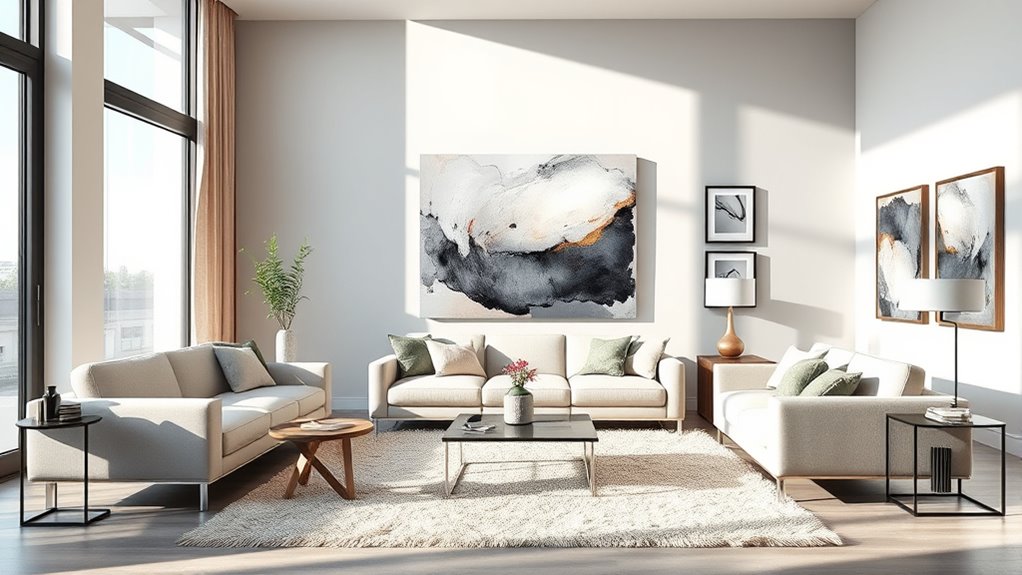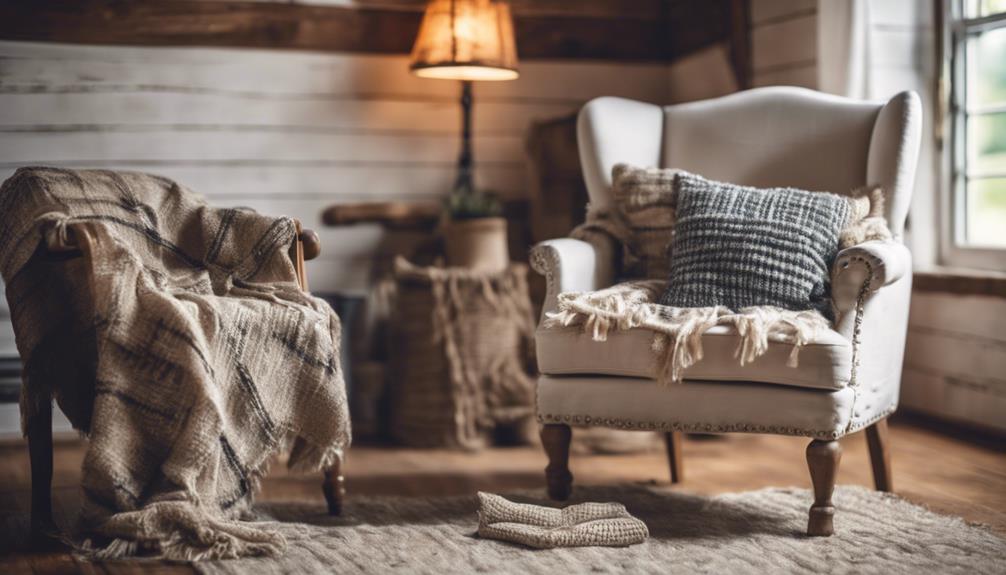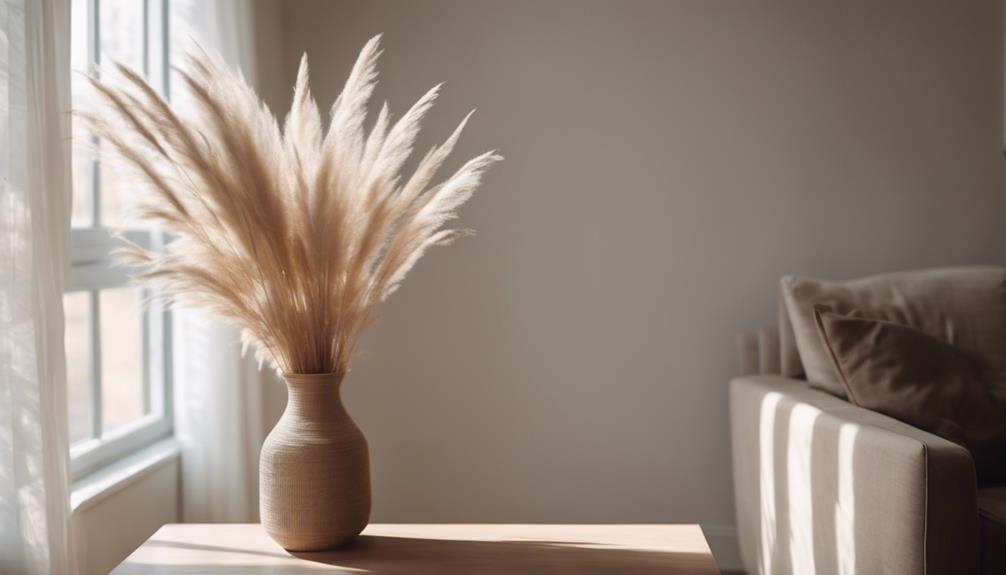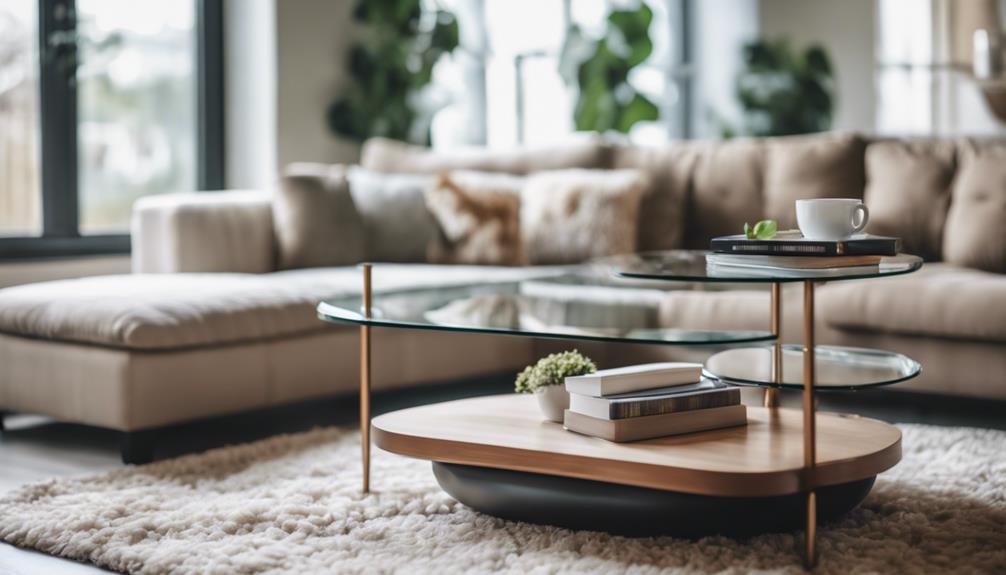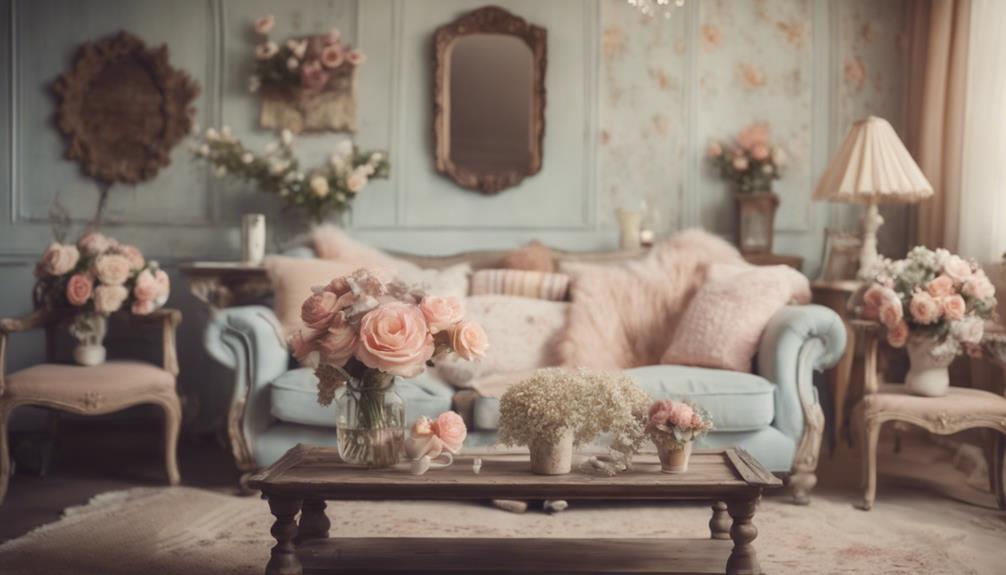To choose artwork sizes like an interior curator, start by considering your wall space and aim for pieces that occupy about 60-75% of it to create balance. Mix large and small artworks to add visual interest, and think about framing styles that enhance each piece while maintaining harmony. Visualize how different sizes flow together and position large works at eye level for impact. Keep these tips in mind, and you’ll discover more ways to master the art of selecting perfect sizes.
Key Takeaways
- Assess wall space, aiming for artwork to occupy about 60-75% of the area for balanced visual impact.
- Vary artwork sizes to create focal points and subtle accents, maintaining overall harmony in the layout.
- Consider the scale of furniture and room proportions to ensure artworks complement rather than overpower the space.
- Use framing styles to enhance artwork size and style, creating cohesion and visual weight across the collection.
- Plan placement at eye level for large pieces and experiment with grouping smaller works for an engaging, curated display.

Selecting the right artwork size can substantially impact the overall harmony of your space. When you’re planning how to display your art, thinking about size is essential. Larger pieces tend to make bold statements and create focal points, while smaller artworks can add subtle accents without overwhelming a room. To get this right, consider your existing gallery layouts—visualize how different sizes will flow together and complement each other within the space. Think about the scale of your furniture and walls; a large piece on a small wall can feel overpowering, whereas a tiny artwork on a big wall might seem lost. Striking the right balance is key to achieving a cohesive look that enhances your room’s personality. Incorporating vintage decor can also influence your artwork choices, helping to create a unified farmhouse aesthetic.
Your framing options also play a significant role in how artwork sizes translate into your interior design. The right frame can elevate a small piece, making it appear more substantial, or add a delicate touch to a larger work. Thick, ornate frames often suit bigger artworks, emphasizing their presence, while slim, minimalist frames work well with smaller pieces or when you’re aiming for a subtle, modern aesthetic. When selecting sizes, consider how the framing will influence the overall visual weight and harmony of your gallery. A well-chosen frame can help create a sense of continuity across varied pieces, tying different sizes together beautifully.
Another thing to keep in mind is how the artwork’s dimensions relate to the wall space. For instance, a good rule of thumb is that artwork should occupy roughly 60-75% of the wall area where it’s displayed. This prevents the piece from feeling cramped or too sparse. When creating a gallery wall, mixing different sizes can add visual interest, but it’s essential to balance them carefully—think about grouping smaller pieces around a dominant larger one or spacing them evenly to maintain harmony. Remember, the goal isn’t just to fill space but to curate a collection that feels intentional and well-composed.
Lastly, the positioning of your artwork matters. Larger pieces work best at eye level, where they can be appreciated fully, while smaller pieces can be grouped higher or lower depending on your aesthetic. When in doubt, measure your wall and your artwork before hanging—this helps you visualize how different sizes will look in context. By paying attention to gallery layouts and framing options, and understanding the importance of scale, you can curate an art display that’s both balanced and striking. When you choose sizes thoughtfully, your walls become a curated showcase that reflects your style and enhances your space seamlessly.
Frequently Asked Questions
How Do Gallery Walls Influence Artwork Size Choices?
Gallery wall layout greatly influences your artwork size choices. A cohesive layout guides you to select pieces that fit well together, creating visual balance. Framing styles also matter, as they can make smaller artworks appear larger or unify varied sizes. You’ll want to choose sizes that complement the overall design, ensuring the wall feels harmonious. By considering layout and framing, you craft a striking gallery wall that reflects your style effortlessly.
What Are Common Mistakes in Selecting Artwork Dimensions?
Choosing artwork dimensions can be like walking a tightrope—balance is key. Common mistakes include neglecting artwork framing, which can make pieces feel disconnected, and ignoring color coordination, causing chaos instead of harmony. You might pick pieces too small for a large wall or overlook the importance of scale, making your space feel unbalanced. Always consider how size, framing, and colors work together to create a cohesive, inviting atmosphere.
How Does Ceiling Height Affect Artwork Sizing?
Ceiling height greatly impacts your artwork sizing choices because taller ceilings allow for larger, more dramatic pieces. Consider ceiling proportions and architectural features when selecting artwork, as high ceilings call for sizable pieces that fill the space without overwhelming it. If your ceiling is low, opt for smaller art to prevent the room from feeling cramped. Balancing artwork with ceiling height creates harmony and emphasizes the room’s architectural character.
Should Artwork Size Match Furniture Scale?
Imagine the perfect harmony in your space—should your artwork size match your furniture? It’s tempting to think so, but the secret lies in balance. You want artwork framing and color coordination to complement, not compete with, your furniture. Choosing slightly larger or smaller pieces creates visual interest and flow. Trust your instincts, and remember, the right-sized artwork can transform your room into a curated masterpiece.
How to Balance Multiple Art Pieces in a Space?
To balance multiple art pieces in a space, focus on creating gallery aesthetics that feel cohesive. Arrange your art with thoughtful art placement, ensuring pieces vary in size but complement each other. Group similar styles or themes, and leave enough space between works to avoid clutter. You’ll achieve a harmonious look that guides the eye naturally, making your display engaging and balanced, just like a professional interior curator would do.
Conclusion
By understanding proportions, considering space, and balancing scale, you create harmony in your home. By choosing artwork sizes that complement your environment, you enhance your space, express your style, and evoke your mood. By paying attention to these details, you turn walls into stories, and rooms into reflections. Remember, the right size isn’t just about fit — it’s about creating a feeling, a vibe, a visual rhythm that makes your space truly yours.
